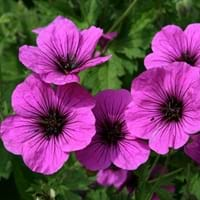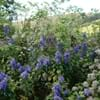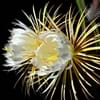Life Span
Perennial
Annual
Type
Flowering Plants
Tender Perennial
Origin
Not Available
Hybrid origin, Mediterranean, Turkey, Canary Islands, Africa, Southern Africa, Madagascar, South Africa, Iraq, Iran, Western Asia
Types
Aconitum napellus
'Americana Bright Red' geranium, 'Allure Light Pink' geranium, 'Candy Cherry' geranium, 'Elegance Imperial' regal geranium
Habitat
Damp shady woods, meadows
Mediterranean region
USDA Hardiness Zone
12-15
12-15
Sunset Zone
21, 22, 23, 24
A2, A3, 1a, 1b, 2a, 2b, 3a, 3b, 4, 5, 6, 7, 8, 9, 10, 11, 12, 13, 14, 15, 16, 17, 18, 19, 20, 21, 22, 23, 24
Habit
Oval or Rounded
Clump-Forming
Flower Color
Yellow
White, Red, Purple, Orange, Pink, Rose, Salmon, Orange Red
Flower Color Modifier
Not Available
Bicolor
Fruit Color
Green
Not Available
Leaf Color in Spring
Not Available
White, Yellow, Red, Green, Purple, Dark Green, Bronze, Orange Red, Ivory
Leaf Color in Summer
Not Available
White, Yellow, Red, Green, Purple, Dark Green, Bronze, Orange Red, Ivory
Leaf Color in Fall
Not Available
White, Yellow, Red, Green, Purple, Dark Green, Bronze, Orange Red, Ivory
Leaf Color in Winter
Not Available
Not Available
Leaf Shape
Compound
Reniform
Plant Season
Not Available
Spring, Summer, Fall, Winter
Sunlight
Not Available
Full Sun, Partial Sun
Growth Rate
Very Slow
Fast
Type of Soil
Not Available
Loam, Sand
The pH of Soil
Not Available
Neutral
Soil Drainage
Not Available
Well drained
Bloom Time
Spring
Indeterminate
Repeat Bloomer
Not Available
Yes
Tolerances
Not Available
Not Available
Where to Plant?
Ground
Container, Ground, Pot
How to Plant?
reseeds
Grafting, Seedlings, Stem Planting
Plant Maintenance
Medium
Medium
Watering Requirements
Do not let dry out between waterings
Prefer drip-irrigation instead of Over-head watering, Requires regular watering, Water Deeply, Water twice a day in the initial period
In Summer
Lots of watering
Lots of watering
In Spring
Moderate
Moderate
In Winter
Average Water
Average Water
Soil pH
Not Available
Neutral
Soil Type
Not Available
Loam, Sand
Soil Drainage Capacity
Not Available
Well drained
Sun Exposure
Not Available
Full Sun, Partial Sun
Pruning
Remove damaged leaves, Remove dead branches, Remove dead leaves
Cut or pinch the stems, No pruning needed in the early stages, Prune if you want to improve plant shape, Prune in spring, Prune to stimulate growth, Remove dead or diseased plant parts, Remove shoots
Fertilizers
All-Purpose Liquid Fertilizer
All-Purpose Liquid Fertilizer
Pests and Diseases
Red blotch
Alternaria Leaf Spot, Bacterial Blight, Bacterial Fasciation, Bacterial leaf spot, Blackleg, Botrytis Blight, Edema, Gray mold, Pseudomonas Leaf Spot, Southern Bacterial Wilt, Stem spot, Verticillium Wilt, Viruses
Plant Tolerance
Drought
Drought
Flowers
Not Available
Yes
Flower Petal Number
Single
Single, Double, Semi-Double
Fragrant Flower
Not Available
Yes
Fragrant Fruit
Not Available
No
Fragrant Leaf
Not Available
Yes
Fragrant Bark/Stem
Not Available
Yes
Showy Foliage
Not Available
Yes
Showy Bark
Not Available
No
Foliage Texture
Bold
Medium
Foliage Sheen
Not Available
Matte
Invasive
Not Available
No
Self-Sowing
Not Available
Yes
Attracts
Hummingbirds
Butterflies
Allergy
poisonous if ingested, Toxic
Sinuses, Throat itching
Aesthetic Uses
Not Used For Aesthetic Purpose
Beautification, Bouquets, Showy Purposes, Used for decorating walls, fences, gates, hedges, etc.
Beauty Benefits
Not Available
Not Available
Environmental Uses
Air purification
Air purification
Medicinal Uses
Analgesic, Anodyne, Diaphoretic, Homeopathy, Used as a sedative
Antibacterial, Diabetes, Inflammation
Part of Plant Used
Root
Flowers, Whole plant
Other Uses
Not Available
Oil is used in perfume, soaps, creams, etc., Used as Ornamental plant, Used for fragrance
Used As Indoor Plant
No
Yes
Used As Outdoor Plant
Yes
Yes
Garden Design
Not Available
Alpine, Bedding Plant, Container, Edging, Foundation, Hanging Basket, Houseplant, Mixed Border, Rock Garden / Wall, Topiary / Bonsai / Espalier, Tropical
Botanical Name
Aconitum
PELARGONIUM
Common Name
aconite, monkshood, wolf's bane, leopard's bane, mousebane, women's bane, devil's helmet, Queen of all Poisons, blue rocket
Florist Geranium, Geranium
In Hindi
बच्छनाभ
Geranium
In German
Eisenhut
Geranie
In French
Queen of all Poisons
Géranium
In Spanish
Queen of all Poisons
Geranio
In Greek
Queen of all Poisons
γεράνι
In Portuguese
Queen of all Poisons
Gerânio
In Polish
Tojad
Pelargonia
In Latin
Queen of all Poisons
Geranium
Phylum
Tracheobionta
Magnoliophyta
Class
Magnoliopsida
Magnoliopsida
Order
Ranunculales
Geraniales
Family
Cactaceae
Geraniaceae
Clade
Angiosperms, Eudicots
Angiosperms, Eudicots, Rosids
Tribe
Delphinieae
Not Available
Subfamily
Not Available
Not Available
Importance of Queen of all Poisons and Geranium
Want to have the most appropriate plant for your garden? You might want to know the importance of Queen of all Poisons and Geranium. Basically, these two plants vary in many aspects. Compare Queen of all Poisons and Geranium as they differ in many characteristics such as their life, care, benefits, facts, etc. Every gardener must at least have the slightest clue about the plants he wants to plant in his garden. Compare their benefits, which differ in many ways like facts and uses. The medicinal use of Queen of all Poisons is Analgesic, Anodyne, Diaphoretic, Homeopathy and Used as a sedative whereas of Geranium is Antibacterial, Diabetes and Inflammation. Queen of all Poisons has beauty benefits as follows: Not Available while Geranium has beauty benefits as follows: Not Available.
Compare Facts of Queen of all Poisons vs Geranium
How to choose the best garden plant for your garden depending upon its facts? Here garden plant comparison will help you to solve this query. Compare the facts of Queen of all Poisons vs Geranium and know which one to choose. As garden plants have benefits and other uses, allergy is also a major drawback of plants for some people. Allergic reactions of Queen of all Poisons are poisonous if ingested and Toxic whereas of Geranium have Sinuses and Throat itching respectively. Having a fruit bearing plant in your garden can be a plus point of your garden. Queen of all Poisons has no showy fruits and Geranium has no showy fruits. Also Queen of all Poisons is not flowering and Geranium is flowering. You can compare Queen of all Poisons and Geranium facts and facts of other plants too.





